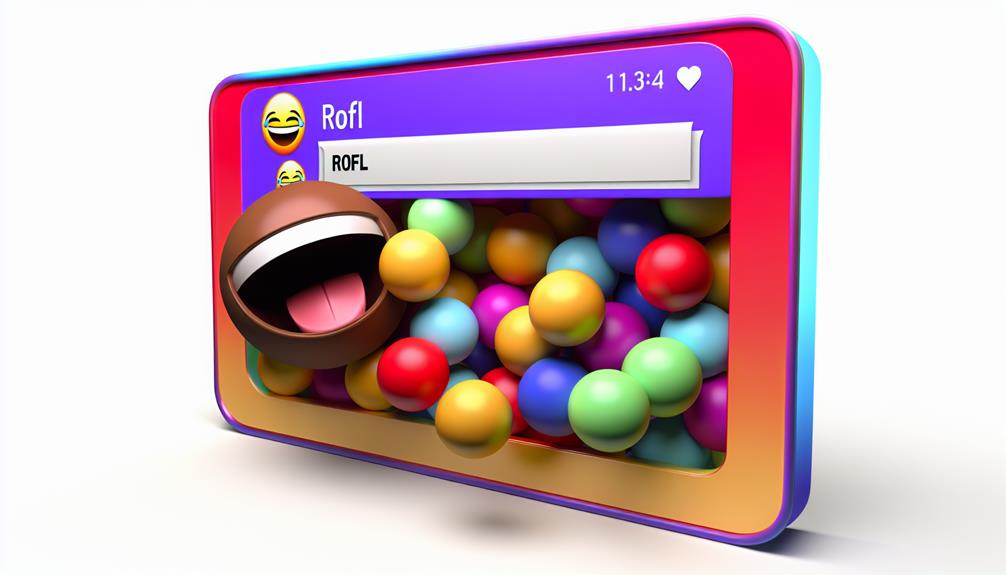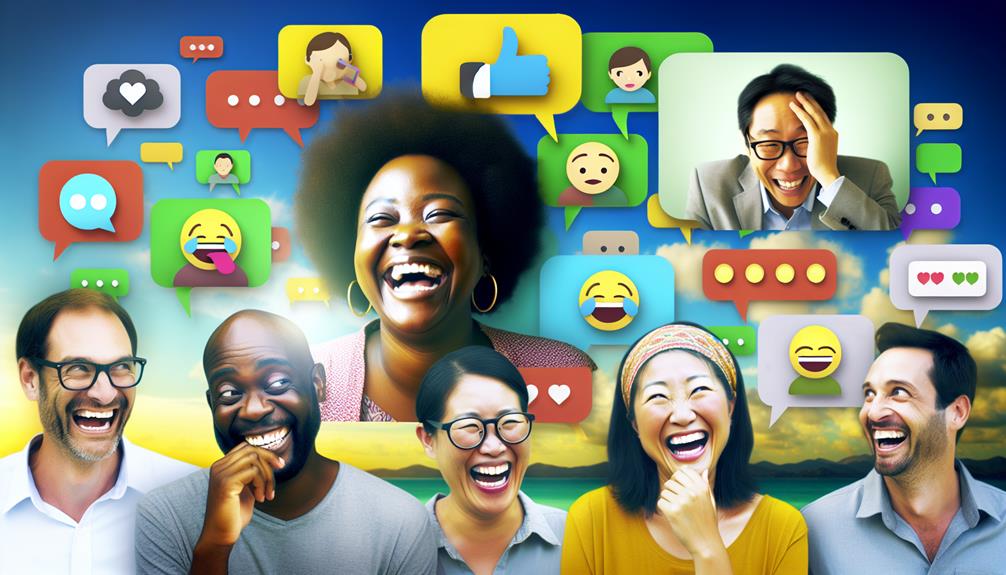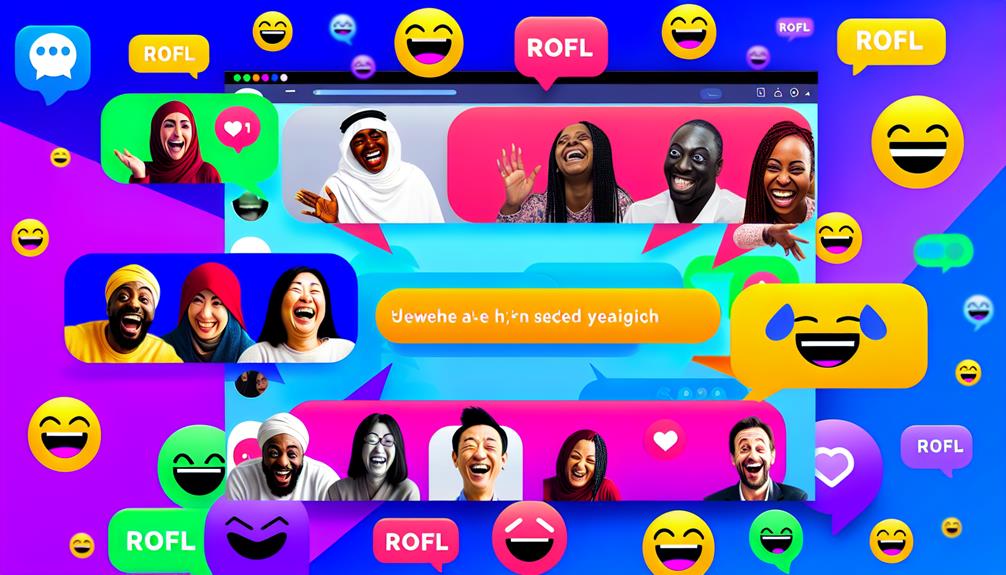ROFL stands for "Rolling On the Floor Laughing," and is widely used in online chats to express deep amusement. Originating in 1989, it reflects the evolution of internet slang and enhances social interactions across various platforms. Ideal for responding to funny memes or humorous exchanges, ROFL cultivates a sense of connection among users. However, it's important to use it sparingly in serious discussions to maintain clarity and professionalism. Alternatives like "LOL" or "LMAO" can add variety to conversations. By mastering these nuances, one can elevate their digital communication style and foster richer interactions. Discover further insights on effective usage.
Key Takeaways
- "ROFL" stands for "Rolling On the Floor Laughing," indicating intense amusement in online conversations.
- It originated in 1989 and grew popular by 1995, showcasing the evolution of internet slang.
- Use "ROFL" in response to funny memes or humorous content to foster connection and camaraderie.
- Alternatives like "LOL," "LMAO," and emojis can vary the expression of humor in chats.
- Be mindful of your audience and context, using "ROFL" sparingly in professional settings to maintain credibility.
Definition of ROFL

The essence of modern digital communication often hinges on brevity and clarity, which is epitomized in the acronym "ROFL." Standing for "Rolling On the Floor Laughing," ROFL is commonly used in online conversations to express intense amusement. This abbreviation is similar to other popular text lingo, such as HBU, which encourages reciprocal engagement in conversations. As part of the broader category of internet slang, ROFL effectively conveys humor in a succinct manner, allowing users to respond quickly while still engaging in lively discourse. This abbreviation has become a staple in various forms of online communication, including social media, texting, and forums, reflecting the evolving language of the digital age. By integrating such expressions, individuals can foster a sense of belonging in virtual communities, enhancing social interactions and shared experiences.
Origin and History
Emerging in the late 1980s and gaining popularity throughout the 1990s, "ROFL" reflects the evolution of internet culture and language. As a form of internet slang, it encapsulates the humor and spontaneity of online interactions. Initially used in chat rooms and forums, "ROFL" quickly spread across various platforms, showcasing its cultural impact on communication.
| Year | Milestone | Cultural Significance |
|---|---|---|
| 1989 | First Recorded Use | Birth of internet slang |
| 1995 | Widespread Adoption | Shift in online communication |
| 2000 | Mainstream Recognition | Integration into daily language |
This evolution not only highlights the playful nature of digital conversations but also fosters a sense of belonging among users.
Contexts for Using ROFL

Utilizing "ROFL" in digital conversations serves to convey genuine amusement and camaraderie among participants. This acronym is particularly effective in responding to funny memes, which often elicit spontaneous laughter and shared enjoyment. When friends exchange humorous content, using "ROFL" signifies not just amusement but also a connection built through laughter. This abbreviation, similar to how "GM" and "GN" serve in greetings, reinforces a friendly tone in chats, promoting a light-hearted atmosphere common text abbreviations. It's essential, however, to practice online etiquette; overusing "ROFL" in inappropriate contexts may dilute its impact. For instance, in serious discussions or professional settings, opting for more subdued expressions of amusement is advisable. In casual chats, though, employing "ROFL" can foster a warm, inviting atmosphere, encouraging others to share their humor and feelings, ultimately enhancing the sense of belonging within the digital community.
Alternatives to ROFL
In digital communication, while "ROFL" effectively expresses amusement, various alternatives exist that can cater to different contexts and audiences. For instance, utilizing plain text pasting tips can help maintain clarity when sharing text that includes these expressions. "LOL" (laughing out loud) is a widely recognized laughing alternative that conveys humor without exaggeration. If you find something particularly funny, "LMAO" (laughing my ass off) adds a touch more enthusiasm. For more casual interactions, "Haha" or "Hehe" can suffice, showcasing a lighthearted tone. Additionally, emojis like �� or �� can visually enhance your texting humor, making your reactions more relatable. These alternatives provide options for varying levels of amusement and connection, allowing you to engage with your audience more effectively while fostering a sense of belonging in your digital conversations.
Tips for Effective Usage

How can one guarantee that the use of "ROFL" and its alternatives enhances communication rather than detracts from it? To ascertain effective usage, consider the emotional impact of your words. "ROFL" conveys laughter and lightheartedness; however, it may not resonate with everyone due to cultural variations. Familiarize yourself with your audience's preferences and sensitivities. Additionally, understanding rewarding career paths can help you communicate more effectively in diverse professional environments. Use "ROFL" sparingly in professional contexts, as it may undermine your credibility. In informal settings, balance its use with genuine dialogue to foster connection. Additionally, be mindful of the context—overusing slang can dilute its meaning. Finally, feel free to mix in alternatives to keep conversations fresh while maintaining an inclusive atmosphere. Embracing these tips will enhance your communication and strengthen bonds within your social circles.
Frequently Asked Questions
Can ROFL Be Used in Formal Communications?
Using informal abbreviations like "ROFL" in formal communications is generally discouraged. While such terms may enhance casual conversations and foster a relaxed atmosphere among peers, they can appear unprofessional in a professional context. It is advisable to maintain a level of formality in written communications, particularly in business settings, to guarantee clarity and convey respect. Adapting language to suit the audience is key to fostering a sense of belonging while maintaining professionalism.
Is ROFL Appropriate for All Ages?
The appropriateness of "ROFL" for all ages largely depends on generational differences and context sensitivity. While younger individuals may readily embrace such informal expressions in casual conversations, older generations might view them as less suitable. Moreover, the context in which "ROFL" is used can greatly influence its reception; what is acceptable in a friendly chat may not be appropriate in more formal settings. Consequently, understanding the audience is essential for effective communication.
How Do Different Cultures Interpret ROFL?
Different cultures interpret digital expressions like "ROFL" through their unique cultural nuances and humor variations. In some cultures, laughter is a communal experience, while in others, it may be more subdued. Consequently, the expression may convey varying degrees of amusement or sarcasm. Understanding these differences fosters inclusivity and connection among individuals from diverse backgrounds, promoting a sense of belonging in conversations that incorporate humor, regardless of cultural context.
Can ROFL Be Misinterpreted in Text?
The potential for misinterpretation of abbreviations like "ROFL" in text communication highlights the significance of context. In various miscommunication scenarios, the intended humor may be lost or misconstrued, leading to confusion among participants. Cultural differences and personal experiences further complicate interpretations, emphasizing the importance of clarity in digital conversations. Understanding the context in which such expressions are used fosters a sense of belonging and encourages more effective communication within diverse groups.
What Are Common Emojis to Use With ROFL?
When expressing laughter in digital communication, incorporating emojis can enhance the emotional tone. Common emojis for laughter include the face with tears of joy ��, the rolling on the floor laughing emoji ��, and the smiling face with open mouth ��. Creative emoji combinations, such as combining these with celebratory icons or humorous faces, can further amplify the intended message. Utilizing these elements fosters a sense of belonging and connection among users in conversations.

